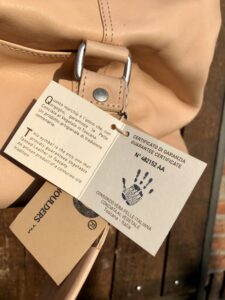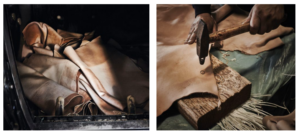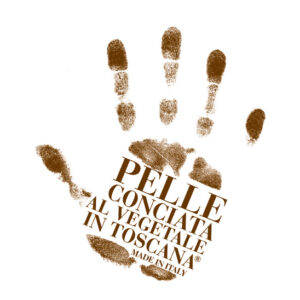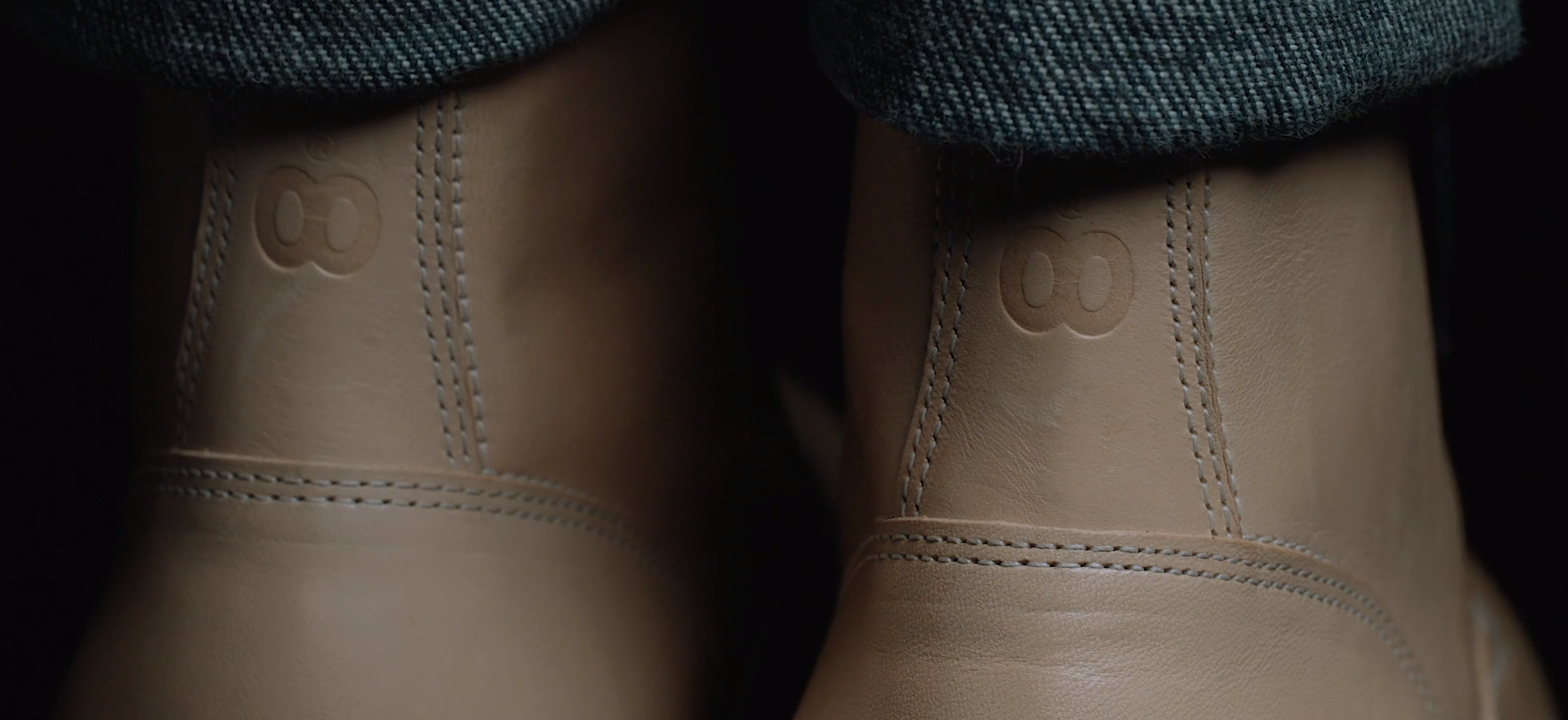Butts and Shoulders only works with partners that are committed to the method of vegetable tanning. No chemicals are used during this special natural tanning process. For our Weekender we work with a new partner called Pelle Conciate al Vegetale Tuscany, an Italian consortium of tanneries. The consortium only uses natural tannins for their vegetable tanned leathers. It is an honor to work with them. Oliviero Toscani conceived the brand name and the logo of Pelle Conciata al Vegetale in Toscana to emphasize the Tuscan origin of leather. The logo tells the story of their product: leather, vegetable tanning extracts and the skillful hands of the Tuscan master tanners, repositories of ancient traditions.

The Natural Tanned Weekender Bag with a Tag of Pelle Conciate al Vegetale Tuscany
To use this quality trademark on our products we are part of the observance of the technical Production Regulations. All their member tanneries are committed to respect the trademark. The document label defines “vegetable-tanned leather”. Stating that the whole productive process of the vegetable tanned leather in its qualifying phases must be made in Tuscany. All of the process fixes strict chemical and physical standards for the leather to be marked “Tuscan Vegetable-Tanned Leather”.
To identify and guarantee that the leather complies with this production Technical Sheet, the Consortium created a guarantee label. This label is followed by a strict product traceability system. Good to know: only the Consortium can allow customers of its member tanneries to use it by signing a contract of license which entitles them to attach the label “Pelle Conciata al Vegetale in Toscana” to their finished product. We, as Butts and Shoulders, signed the contract and respect the label.

Natural leather hides in the tumbler of the tannery
The following quote on the website shows why the partnership between Butts and Shoulders and the consortium is so well fitting:
“Vegetable-tanned leather absorbs the traces of our life, it matures without ruining. The natural ageing does not compromise its resistance. It reveals the signs of time and use as the most personal expression of naturalness and truth. The colours of tannins give the leather an unmistakable warm and brilliant shade that becomes more intense with the passing of time and the daily use.”
This is also the core of our brand. We value the true benefits of vegetable tanned leather. And we are committed to make good use of this beautiful product. The fact that it is actually a waste product makes it even better. It is a win-win situation. Durable fashion, natural materials.

Pelle Conciate al Vegetale Tuscany
So, why does this matter? Why is this such a big deal for us? We believe in the quality of leather and therefore the durability of our products. Slow fashion is the anti-thesis of fast fashion. We see a lot of junk on the market, made for single usage. Apart from the materials used, this way of consumerism isn’t right and very harmful for the environment. We do understand that leather is the skin of an animal. But the hides are a waste product of the meat-industry. So, you can state that we use the skin instead of it being disposed.
This is just one way to look at it. On the other side you have the tanning process of the leather. This is probably the most harmful for the environment. Most leather that is used for the fashion industry is produced for the fast fashion industry. Leather from Chinese or Indian tanneries for bags, jackets and footwear. These tanneries use toxics and there the process of tanning is extremely harmful for the environment and the people working in the tanneries. The toxics, like chrome, turns into carcinogenic chromium (VI) and is dumped in the water, turning up in surface waters which are used for washing, drinking and irrigation of the land. While leather can be tanned with non-toxic vegetable dyes, chrome tanning is faster and produces a flexible leather that’s better for high-end bags and coats, so there’s no incentive for factories to switch.
But this is not the way. Chemicals should be banned. Go for vegetable tanned leather.


[…] In an earlier blog we highlighted the differences between the two tanning methods. During the natural process of tanning, the tannins of bark, leaves and plants bind the collagen proteins in the hide and protect them so they are less harmful for water penetration and bacterial affections. In contrast, chrome tanning has a different approach which is commercially far more interesting because of the speed of the process. And thereby, the leather will not ‘live’ anymore and so the colour stays the same over time. For the mass market, this is a well appreciated aspect of leather, but our preferences are different. The biggest downside of all these chemicals: it kills the environment. Solid and liquid waste that contains leftover chromium is dumped in the environment. Tanning one ton of hide typically results in 20 to 80 cubic meters of wastewater with Chromium concentrations around 250 mg/L and sulfide concentrations at roughly 500 mg/L. Therefore, we only want to work with vegetable tanned leather. Tanning with natural materials. And partners in Europe. Partners that have high standards for health and safety regulations. Read about our latest partner; Pele Conciate el Vegetable. […]
[…] the passion from the craftsman we work with, in The Netherlands, but also Portugal. Our leather is 100% chemical free. So no harmful toxics will enter the atmosphere and the soil. In most cases, leather is made in […]